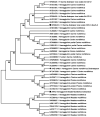Canine Morbillivirus from Colombian Lineage Exhibits In Silico and In Vitro Potential to Infect Human Cells
- PMID: 34578231
- PMCID: PMC8471232
- DOI: 10.3390/pathogens10091199
Canine Morbillivirus from Colombian Lineage Exhibits In Silico and In Vitro Potential to Infect Human Cells
Retraction in
-
Retraction: Rendon-Marin et al. Canine Morbillivirus from Colombian Lineage Exhibits In Silico and In Vitro Potential to Infect Human Cells. Pathogens 2021, 10, 1199.Pathogens. 2022 Nov 14;11(11):1348. doi: 10.3390/pathogens11111348. Pathogens. 2022. PMID: 36422643 Free PMC article.
Abstract
Canine morbillivirus (CDV) is a viral agent that infects domestic dogs and a vast array of wildlife species. It belongs to the Paramyxoviridae family, genus Morbillivirus, which is shared with the Measles virus (MeV). Both viruses employ orthologous cellular receptors, SLAM in mononuclear cells and Nectin-4 in epithelial cells, to enter the cells. Although CDV and MeV hemagglutinin (H) have similar functions in viral pathogenesis and cell tropism, the potential interaction of CDV-H protein with human cellular receptors is still uncertain. Considering that CDV is classified as a multi-host pathogen, the potential risk of CDV transmission to humans has not been fully discarded. In this study, we aimed to evaluate both in silico and in vitro, whether there is a cross-species transmission potential from CDV to humans. To accomplish this, the CDV-H protein belonging to the Colombian lineage was modelled. After model validations, molecular docking and molecular dynamics simulations were carried out between Colombian CDV-H protein and canine and human cellular receptors to determine different aspects of the protein-protein interactions. Moreover, cell lines expressing orthologous cellular receptors, with both reference and wild-type CDV strains, were conducted to determine the CDV cross-species transmission potential from an in vitro model. This in silico and in vitro approach suggests the possibility that CDV interacts with ortholog human SLAM (hSLAM) and human Nectin-4 receptors to infect human cell lines, which could imply a potential cross-species transmission of CDV from dogs to humans.
Keywords: Nectin-4; SLAM molecule; canine distemper; cellular receptor; inter-species transmission.
Conflict of interest statement
The authors declare that they do not have anything to disclose regarding conflicts of interest with respect to this manuscript.
Figures






Similar articles
-
Canine Distemper Virus Spread and Transmission to Naive Ferrets: Selective Pressure on Signaling Lymphocyte Activation Molecule-Dependent Entry.J Virol. 2018 Jul 17;92(15):e00669-18. doi: 10.1128/JVI.00669-18. Print 2018 Aug 1. J Virol. 2018. PMID: 29793948 Free PMC article.
-
LRP6 Is a Functional Receptor for Attenuated Canine Distemper Virus.mBio. 2023 Feb 28;14(1):e0311422. doi: 10.1128/mbio.03114-22. Epub 2023 Jan 16. mBio. 2023. PMID: 36645301 Free PMC article.
-
Evolution and Interspecies Transmission of Canine Distemper Virus-An Outlook of the Diverse Evolutionary Landscapes of a Multi-Host Virus.Viruses. 2019 Jun 26;11(7):582. doi: 10.3390/v11070582. Viruses. 2019. PMID: 31247987 Free PMC article. Review.
-
Rational attenuation of canine distemper virus (CDV) to develop a morbillivirus animal model that mimics measles in humans.J Virol. 2024 Mar 19;98(3):e0185023. doi: 10.1128/jvi.01850-23. Epub 2024 Feb 28. J Virol. 2024. PMID: 38415596 Free PMC article.
-
Tropism and molecular pathogenesis of canine distemper virus.Virol J. 2019 Mar 7;16(1):30. doi: 10.1186/s12985-019-1136-6. Virol J. 2019. PMID: 30845967 Free PMC article. Review.
Cited by
-
Morbillivirus: A highly adaptable viral genus.Heliyon. 2023 Jul 7;9(7):e18095. doi: 10.1016/j.heliyon.2023.e18095. eCollection 2023 Jul. Heliyon. 2023. PMID: 37483821 Free PMC article. Review.
-
Retraction: Rendon-Marin et al. Canine Morbillivirus from Colombian Lineage Exhibits In Silico and In Vitro Potential to Infect Human Cells. Pathogens 2021, 10, 1199.Pathogens. 2022 Nov 14;11(11):1348. doi: 10.3390/pathogens11111348. Pathogens. 2022. PMID: 36422643 Free PMC article.
-
Reconstruction of the Evolutionary Origin, Phylodynamics, and Phylogeography of the Porcine Circovirus Type 3.Front Microbiol. 2022 May 18;13:898212. doi: 10.3389/fmicb.2022.898212. eCollection 2022. Front Microbiol. 2022. PMID: 35663871 Free PMC article.
References
-
- MacLachlan N., Dubovi E., Fenner F. Fenner’s Veterinary Virology. 4th ed. Elsevier; Amsterdam, The Netherlands: 2011. pp. 299–325.
-
- Lamb R.A., Parks G.D. Fields Virology. 6th ed. Wolters Kluwer Health Adis (ESP); Philadelphia, PA, USA: 2013. Paramyxoviridae.
Publication types
Grants and funding
LinkOut - more resources
Full Text Sources

